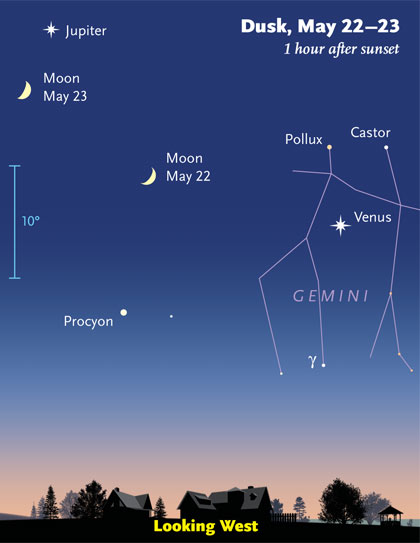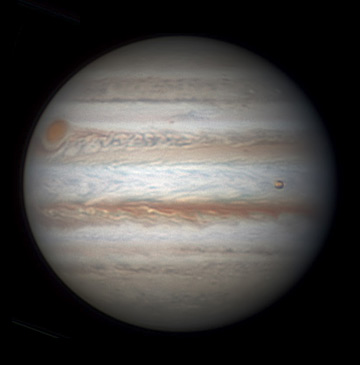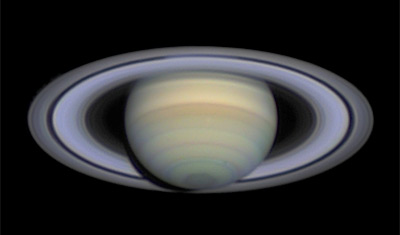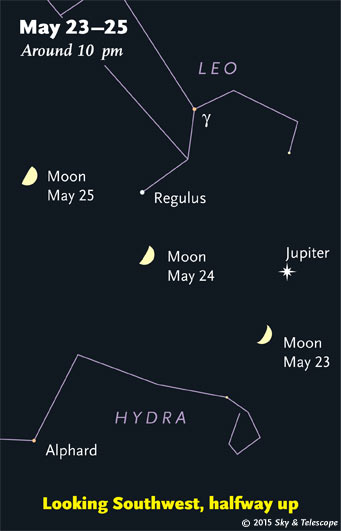Some daily sky sights among the ever-changing Moon, planets, and stars.
More than two months after it erupted, the nova in the Sagittarius Teapot continues to oscillate between about magnitude 4.5 and 6.6, with an increasing downward trend. As of May 27th it was about 6.5, and quite red. See article with charts and a link to an up-to-date light curve.

Look below the waxing crescent Moon this evening for Procyon, the Little Dog Star, as shown here. To the right of the Moon shines brilliant Venus with Pollux and Castor over it.
Saturday, May 23
The Moon positions itself under Jupiter this evening. They may look close together, but Jupiter is currently 2,100 times farther away — which is just as well, since it's 26,000 times as massive!
Sunday, May 24
Venus now forms an almost perfectly right triangle with Pollux and Castor. Venus is on its way to lining up with them (to their left) on June 1st.
Monday, May 25
First-quarter Moon (exact at 1:19 p.m. EDT). The Moon forms a long line with Jupiter to its lower right and Venus farther lower right. They're the three brightest celestial objects after the Sun. As the stars come out, you'll find Regulus not quite between the Moon and Jupiter.
Tuesday, May 26
Three doubles under Saturn. Once Saturn has risen well up in the southeast in late evening, examine the little star 2° below it. That's Beta (β) Scorpii, a fine double star for telescopes. Another 1° below that is the very wide naked-eye pair Omega1 and Omega2 Scorpii, nearly vertical. Binoculars show their slight color difference. Left or lower left of Beta by 1.6° is Nu Scorpii, another fine telescopic double. High power in good seeing reveals Nu's brighter component itself to be a close binary, separation 2 arcseconds.
Wednesday, May 27
Action at Jupiter. Ganymede and Io both cast their tiny (but unequal) black shadows onto Jupiter's face tonight from 10:01 p.m. EDT to 12:18 a.m. EDT. Meanwhile, Jupiter's Great Red Spot crosses the planet's central meridian around 10:46 p.m. EDT.
Thursday, May 28
This evening, Spica shines to the lower left of the gibbous Moon. Watch the Moon draw closer to it through the night. Spica is a very hot star that's nearly as blue as a star can get — which is still only pale blue-white, no matter how much higher the temperature goes!
Friday, May 29
As the stars come out, you'll find Spica only a few degrees right of the Moon (at the time of dusk for North America). The Moon draws farther away from it through the night.
Saturday, May 30
The Moon this evening shines almost halfway from Spica (off to the Moon's upper right, by more than a fist at arm's length) to Saturn (down to the Moon's lower left). One fist below Saturn, you'll find fiery orange Antares.
__________________________
Want to become a better astronomer? Learn your way around the constellations. They're the key to locating everything fainter and deeper to hunt with binoculars or a telescope.

Once you get a telescope, to put it to good use you'll need a detailed, large-scale sky atlas (set of charts). The standards are the little Pocket Sky Atlas, which shows stars to magnitude 7.6; the larger and deeper Sky Atlas 2000.0 (stars to magnitude 8.5); and once you know your way around, the even larger Uranometria 2000.0 (stars to magnitude 9.75). And read how to use sky charts with a telescope.
You'll also want a good deep-sky guidebook, such as Sue French's Deep-Sky Wonders collection (which includes its own charts), Sky Atlas 2000.0 Companion by Strong and Sinnott, the bigger Night Sky Observer's Guide by Kepple and Sanner, or the beloved if dated Burnham's Celestial Handbook.
Can a computerized telescope replace charts? Not for beginners, I don't think, and not on mounts and tripods that are less than top-quality mechanically (able to point with better than 0.2° repeatability, which means fairly heavy and expensive). As Terence Dickinson and Alan Dyer say in their Backyard Astronomer's Guide, "A full appreciation of the universe cannot come without developing the skills to find things in the sky and understanding how the sky works. This knowledge comes only by spending time under the stars with star maps in hand."
This Week's Planet Roundup


Mercury is hidden in the glare of the Sun.
Venus (magnitude –4.3, in Gemini near Pollux and Castor) is the most brilliant point in the west during and after twilight. It doesn't set in the west-northwest until almost two hours after dark. In a telescope Venus is just about at dichotomy: "half-moon" phase.
Mars is lost in the sunset.
Jupiter (magnitude –2.0, at the Cancer-Leo border) shines high in the west to the upper left of Venus. These two brightest of planets are closing in toward each other: from 29° apart on May 22nd to 23° apart on the 29th. They're on their way to a spectacularly close conjunction at the end of June.
Saturn (magnitude 0.0, just above the head of Scorpius) comes to opposition on May 22nd. It shines low in the southeast in twilight, higher after dark, and it's essentially at its highest in the south by midnight. Some 10° below Saturn during evening is twinklier orange Antares, less bright. In a telescope, Saturn's rings are tilted a broad 24° from edgewise. For the clutch of double stars just south of Saturn, see the entry for May 26th above.
Uranus (magnitude +5.9, in Pisces) is very low in the east as dawn begins to brighten.
Neptune (magnitude +7.9, in Aquarius) is in the east-southeast before the first light of dawn.
__________________________
All descriptions that relate to your horizon — including the words up, down, right, and left — are written for the world's mid-northern latitudes. Descriptions that also depend on longitude (mainly Moon positions) are for North America.
Eastern Daylight Time (EDT) is Universal Time (UT, UTC, or GMT) minus 4 hours.
__________________________
“This adventure is made possible by generations of searchers strictly adhering to a simple set of rules. Test ideas by experiments and observations. Build on those ideas that pass the test. Reject the ones that fail. Follow the evidence wherever it leads, and question everything. Accept these terms, and the cosmos is yours.”
— Neil deGrasse Tyson, 2014.
 1
1

Comments
Tom Hoffelder
May 24, 2015 at 10:25 am
Thanks for the double shadow info on the 27th - always a cool thing to see! I think Jupe will still be high enough to see from here in Maine, at least early during the event.
Maybe it is noted somewhere here on S&T.com, but Comet Lovejoy will be within 90' of Polaris on the 26th thru the 29th. With the moon in the sky, the comet being about 8th mag and a relatively small scope required for that field of view, I'm not sure how easy it will be to see them together, but I hope to try since I've seen 134 comets, but never one in the field with Polaris.
You must be logged in to post a comment.
You must be logged in to post a comment.